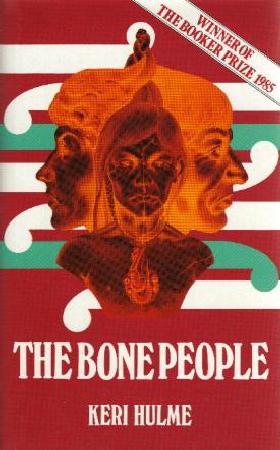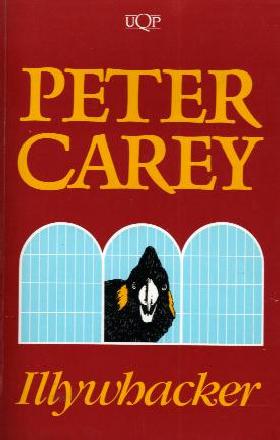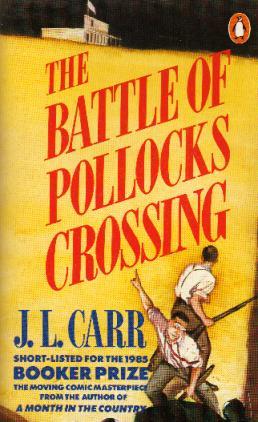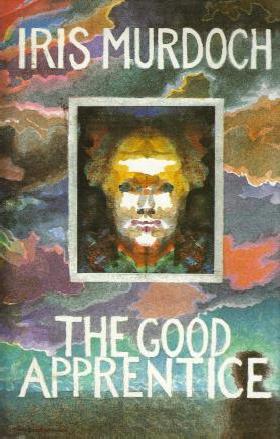
Keri Hulme
The following novels constitute the shortlist for the 1985 Booker Prize:
Notable Omissions from the 1985 Shortlist

|
The Bone People Keri Hulme |
Dustjacket synopsis:
"The Bone People is an extraordinary novel blending reality with dreams, melding Maori and
European, weaving strange and hurtful pasts into strangely bright futures.
"A literary tour de force, this unusual, painfully-felt novel focuses on a strange and uneasy triangle. Kerewin, a sometime artist living alone on the edge of the sea, finds her solitary, self-sufficient life interrupted by the arrival of a silent urchin who communicates with her by sign language. He is claimed eventually by his stepfather, whose relationship with the boy often erupts into violence, frustration and despair.
"The Bone People is an extraordinary, alive and intense book, which has already been widely acclaimed in Keri Hulme's native New Zealand. It scrutinises closely, in fresh and original language, the equivocal faces of love."
Quotes:
"The power and feeling for nature and the more mystical sides of a dwindling people, the
Maoris, will make it a gem providing a whole new range of experience." - Martyn Goff, Daily Telegraph
"Keri Hulme writes rawly in a style uniquely hers, and strikes you as the voice of a new
civilisation, breaking silence with an originality that shocks and moves." - David Hughes, The Mail on Sunday
"Rich, varied and flexible...the story becomes utterly compelling." - Fleur Adcock, New Society
"The Bone People is a masterpiece...to convey such a vision of life in a story, from
Inferno to Paradiso as it were, requires a narrative gift of a high order." - D.N. Ballantyne, Otago Daily Times
"It is beautiful and terrible. It is tender and cruel. It is dream and reality. It is poetry
and crudity. It is infinitely simple and infinitely complex." - Susan Graham, New Zealand Herald
"This is a novel of rhetoric; inner and outer voices weave their turbulant patterns, maintaining
anxiety." - Norman Shrapnel, The Guardian
"It has a tumbling vehemence and a passionate sincerity." - Allan Massie, The Scotsman
First Paragraph:
He walks down the street. The asphalt reels by him.
It is all silence.
The silence is music.
He is the singer.
The people passing smile and shake their heads.
He holds a hand out to them.
They open their hands like flowers, shyly.
He smiles with them.
The light is blinding: he loves the light.
They are the light.
...
He walks down the street. The asphalt is hot and soft with sun.
The people passing smile, and call out greetings.
He smiles and calls back.
His mind is full of change and curve and hope, and he knows it is being lightly tapped. He laughs.
Maybe there is the dance, as she says. Creation and change, destruction and change.
New marae from the old marae, a beginning from the end.
His mind weaves it into a spiral fretted with stars.
He holds out his hand, and it is gently taken.
...
She walks down the street. The asphalt sinks beneath her muscled feet.
She whistles softly as she walks. Sometimes she smiles.
The people passing smile too, but duck their heads in a deferential though her smile is too sharp.
She grins more at their lowered heads. She can dig out each thought, each reaction, out from the grey brains, out
through the bones. She knows how. She knows a lot.
She is eager to know more.
But for now there is the sun at her back, and home here, and the free wind all round.
And them, shuffling ahead in the strange-paced dance. She quickens her steps until she has reached them.
And she sings as she takes their hands.
From the Spiral and Hodder & Stoughton hardback edition, 1985.

|
Illywhacker Peter Carey |
Quotes:
"Illywhacker is such an astonishing novel, of such major proportions, that before saying
anything else one must record gratitude for its existence." - Geoffrey Dutton, Bulletin
"The finest and funniest picaresque novel yet written in Australia" - Peter Pierce National Times
"A great tottering tower of a novel which stands up astonishingly against all the odds." -
Victoria Glendinning, London Sunday Times
"It is impossible to convey in a review the cumulative brilliance and accelerating hilarity of
the prose." - Nicholas Spice, London Review of Books
"Awesome breadth, ambition and downright narrative joy...Illywhacker is a triumph." -
Curt Suplee, Washington Post
"A sprawling, inventive and deeply absorbing saga...It is also one of the funniest, most
vividly depicted, most entertainingly devious and bitterly insightful pieces of fiction to
be published in recent years." - Alida Becker Newsday
First Paragraph:
My name is Herbert Badgery. I am a hundred and thirty-nine years old and something of a celebrity. They come and look at me and wonder how I do it. There are weeks when I wonder the same, whole stretches of terrible time. It is hard to believe you can feel so bad and still not die.
I am a terrible liar and I have always been a liar. I say that early to set things straight. Caveat emptor. My age is the one fact you can rely on, and not because I say so, but because it has been publicly authenticated. Independent experts have poked me and prodded me and scraped around my foul-smelling mouth. They have measured my ankles and looked at my legs. It is a relief not to worry about my legs any more. When they photographed me I did not care that my dick looked as scabby and scaly as a horse's, even though there was a time when I was a vain man and would not have permitted the type of photographs they chose to take. Apart from this (and it is all there, neatly printed on a chart not three feet from where I lie) I have also been written up in the papers. Don't imagine this is a novelty to me - being written up has been one of my weaknesses and I don't mention it now so that I may impress you, but rather to make the point that I am not lying about my age.
From the UQP paperback edition, 1988.
You can read further details of this and other novel by Peter Carey novel on this webpage.

|
The Battle of Pollock's Crossing J.L. Carr |
Dustjacket synopsis:
"When George Gidner, teacher at Balaclava Road Elementary School, Bradford, has an opportunity
to spend a year teaching in America, he can't believe his luck. But Palisades, South Dakota,
is a Depression-struck outpost of mind-numbing awfulness in the middle of nowhere: a place where
more than a few American dreams are rapidly becoming nightmares - and one of them is the Battle
of Pollocks Crossing."
Quotes:
"Confirms this good writer as possessing a novelist's most essential gift, his own inalienable
voice. Wayward, ambiguous, eccentric...a fascinatingly outlandish novel" - Norman Shrapnel, The Guardian
"Not to be missed" - Daily Express
"Carr of Kettering is a rare and pecious specimen, producing commanding and idiosyncratic
fiction, unaffected by anyone else's fashion or theory" - The Times Literary Supplement
First Paragraph:
'No, not if ten Vice-Presidents and each with two heads on his neck were coming to unveil it,' Mr Gidner said sourly. 'God willing - and I'm pretty sure he is - I never again shall set foot in your United States. Never!
'Guest of Honour? Honour! What has honour to do with Pollocks Crossing?
'And this monument you go on about! On a bucking bronco like Buffalo Bill? No? Just a State Tourist Commission cast-iron marker! Well, get the inscription right. What about this?'
From the Penguin paperback edition, 1985.

|
The Good Terrorist Doris Lessing |
Dustjacket synopsis:
"The scene is contemporary London, where a loose-knit group of political vagabonds comprises an
ill-defined and volatile underground. Drifting from one cause to the next, they occupy
abandoned houses, demonstrate and picket, devise strategies to fit situations that may or may
not arise. But, within this world, one particular commune - one small group of mem and women
whose deepest conviction seems to rest in a sense of their own largely untested radicalism - is
moving inexorably toward active terrorism.
"At their center is Alice Mellings, who, though not the leader, is nevertheless the engine of the group. A brilliant organizer, Alice (in her mid-thirties) knows how to cope with almost anything, except the vacuum of her own life. And so we find her - in the latest of countless squatters' communes she's inhabited during the past fifteen years - once again taking charge, taking care, being practical. Alice: fixing, replacing, conniving, convincing, cooking. Alice: always there, always reliable, giving her time and effort to running the house so that the others are free to take part in the demonstrations that are the motivating force of their lives. Alice: making herself indispensable - and invisible; earning a precious sense of belonging by denying her own sense of self.
"Suddenly, however, the stakes are rising. Some of the group appear to have ties to insurgents in Northern Ireland and even to Soviets who are "recruiting"..a small bomb set off on a deserted street leads to ideas that are dangerously ambitious...a crate of guns is left at the house for reasons alice and her companions don't want to fully understand...and there is a man, a "professional", who is eager to meet with Alice and discuss her future with his organization...
"Now there is dissension within the commune, a dissolution of the already tenuous focus and spirit that has so far kept it whole, and Alice finds herself at the center again. But this time it is the center of a circle on the verge of collapse, and it falls to her to make decisions that entail a kind of terrorism - political and personal - that she has never really meant to involve herself in, but which, finally, she may be helpless to avoid.
"In The Good Terrorist Doris Lessing has given us not only an extraordinarily vivid picture of communal life and lives (the leader, who guards his lair with oppressive jealousy; the imposing female "lieutenant", whose strength goes far beyond those she serves; the madwoman, whose political actions may be the only vent for her severe emotional turmoil; the hangers-on, the intruders, the abusers, the abused), but also a profoundly intuited and timely portrait of the kind of personalities - who they are, how they function, what makes them tick - that can be drawn to this dangerous and frightening way of life."
First Paragraph:
The house was set back from the noisy main road in what seemd to be a rubbish tip. A large house. Solid. Black tiles stood at angles along the gutter, and into a gap near the base of a fat chimney a bird flew, trailing a piece of grass several times its length.
"I should think 1910," said Alice. "Look how thick the walls are." This could be seen through the broken window just above them on the first floor. She got no response, but nevertheless shrugged off her backpack, letting it tumble onto a living rug of young nettles that was trying to digest rusting tins and plastic cups. She took a step back to get a better view of the roof. This brought Jasper into vision. His face, as she expected it would be, was critical and meant to be noticed. For her part, she did not have to be told and she was wearing her look, described by him as silly. "Stop it," he ordered. His hand shot out and her wrist was encircled by hard bone. It hurt. She faced him, undefiant but confident, and said, "I wonder if they will accept us?" And, as she had known he would, he said, "It is a question of whether we will accept them."
From the Knopf hardback edition, 1985.

|
Last Letters from Hav Jan Morris |
Dustjacket synopsis:
"In the last months before the events of 1985 which irrevocably altered the character of the place, Jan Morris was commissioned by an American magazine to write a series of letters from Hav. She remained there until the day of the invasion, and this book is the result. It is the first substantial portrait ever drawn of a city which enthralled such literary visitors as Marco Polo, Mark Twain, Tolstoy and D.H. Lawrence, but which remained, thanks to its political and geographical situation, virtually unknown to ordinary travellers.
"Jan Morris, who has probably described more cities than any other travel writer in history, is uniquely qualified to catch the spirit of this remarkable place in its dying days. She moves easily from the fashionable glitter of the old Russian colony to the high hopes of the Tripartite Mandate, from the secluded luxuries of Casino Cove to the fascinating society of the troglodytic Kretevs. She captures the arcane excitement of the Roof-Race, one of the most astonishing sporting events in Europe, the seedy glamour of Hav's ancient waterways, the gilded splendours of the famous Serai, and she introduceses us to a cast of characters that includes Diaghilev, Freud, Lawrence of Arabia and the last claimant to the Caliphate.
"It was Jan Morris's first visit to Hav, and a frank sense of bafflement runs through the book. Her somewhat hazy penetration of the city's confused affairs (culminating in a seance of that peculiar medieval cult, the Hav Cathars) is haunted month by month by a growing premonition of the catastrophe to come. The letters inevitably end sadly, but they will remain a bright memorial to the life and spirit of a city which was in many ways an allegory or archetype of the Levantine condition."
First Paragraph:
I did what Tolstoy did, and jumped out of the train when it stopped in the evening at the old frontier. Far up at the front the engine desultorily gasped, and wan faces watched me through crusted carriage windows as I walked all alone down the platform to the gate. There was no pony trap waiting for me of course (Tolstoy's reminded him sadly of picnics at Yasnaya Polyana), but a smart enough green Fiat stood in the station yard, a young man in sun-glasses and a blue blazer beckoned me from the wheel, and in no time we were off along the rutted track towards the ridge.
From the Viking hardback edition, 1985.

|
The Good Apprentice Iris Murdoch |
Dustjacket synopsis:
"Stuart Cuno has decided to become good. Not believing in God, he invents his own methods,
which include celibacy, chastity and the abandonment of a promising academic career. Interfering
friends and relations question his sincerity, his sanity and his motives. Stuart's step-brother
Edward Baltram is tormented by guilt because he has, he believes, killed his best friend. He
dreams sometimes of redemption, sometimes of suicide. Edward is sent on a 'journey to the
underworld' to find his natural father, the painter Jesse Baltram, whom he has not seen since
childhood. He discovers a father strangely different from his expectations, and succumbs to an
enchantment quite unlike the redemptive cure for which he has been seeking; and meets perhaps the
one person in the world who has the power to forgive him. Meanwhile Stuart's moral apprenticeship
is causing nothing but trouble. Coming to rescue Edward, Stuart provokes a final catastrophic
clash of forces. Funny, compelling and extremely moving, Iris Murdoch's new novel is about
obsessive guilt-ridden despair, and the difficult problem of how to try to be good - and the
various magical devices which console those who are sensible enough not to try."
First Paragraph:
I will arise and go to my father, and will say unto him, Father I have sinned against heaven and before thee, and am no more worthy to be called thy son.
There were not perhaps the actual words which Edward Baltram uttered to himself on the occasion of his momentous and mysterious summons, yet their echo was not absent even then, and later he repeated them often.
From the Chatto & Windus hardback edition, 1985.
Notable Omissions from the Shortlist:
"Hawksmoor", Peter Ackroyd
"Family and Friends", Anita Brookner
"Crusoe's Daughter", Jane Gardam
"Black Robe", Brian Moore
"Paradise Postponed", John Mortimer
"Oranges are Not the Only Fruit", Jeanette Winterson
This page and its contents are copyright © 2002-05 by Perry Middlemiss, Melbourne, Victoria, Australia.
Last modified: October 24, 2005.